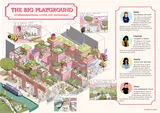Case Study
Guiding future garden community development in Hemel Hempstead

Selma Hooley shares her reflections after a year working in local government as Dacorum Borough Council Lead in Hemel Garden Communities team.
My background
Just over a year ago, as a Public Practice Associate, I joined the Hemel Garden Communities (HGC) team as a Dacorum Borough Council Lead Officer. This was after working in the private sector in master planning for many years throughout my career.
With my broad multidisciplinary experience and the recent Government’s elevated urban design agenda, I felt I could use my technical transferable skills, including placemaking, strategic master planning and urban design, to make a difference in delivering some of the places I believe in and make effective, wide-reaching positive change.
I cannot deny it—it has been a journey of ‘stepping into an unknown’—an enjoyable journey nonetheless if you like ‘exploring’ and growing professionally. My past year has been rather fulfilling due to, amongst other things, varied and interesting work, and valuable support from the Public Practice programme and my Hemel Garden Community Team colleagues. I do feel it has put a spring in my step and made me much richer as a person having made this change arguably quite late in my career (do it earlier if you can!).
The transition from the private to the public sector was made smoother by the welcoming HGC team, including my line manager who had a full appreciation of my experience and skills but also understood I would not be familiar with all the ways of public sector working and eased me in gradually with tasks and responsibilities. A number of my colleagues had arrived at roles through similar Public Practice routes and were ready to help me find my feet in the big world of multiple stakeholders, landowners, partners, local authority and county officers, and priorities.
Over the first year, the Associate Programme Learning & Development course gently guided us through the ways of working in the public sector.
This came as a nice relief from my day-to-day role and provided invaluable content carefully selected to help me along the way. Exchanging our placement stories within the cohort and having this instant community of practice you could check in with, where no question is a silly question – was encouraging and comforting.

Placement
In my placement, the key task I have been leading is managing the update of the Framework Plan, a key activity in the overall HGC programme. This holistic plan guides the future development and infrastructure needs of the growth areas and the transformation of the existing town until 2050.
Hemel Garden Communities is one of the 43 areas in the national Garden Communities programme. Its ambition is not only to deliver 11,000 new homes and 10,000 jobs but also to support the transformation of the existing town, which will enhance people’s health and wellbeing, offer employment opportunities, and encourage communities to thrive.
Hemel Hempstead, though an ancient town (not many know it has existed since at least the 8th century and was granted its town charter by Henry VIII), was developed and designated as a New Town after the Second World War. The original design by Geoffrey Jellicoe had a strong placemaking vision for Hemel Hempstead to be a 'city within a park'. The challenge we face today is staying true to that original Jellicoe Vision of green spaces and connected and well-served neighbourhoods, whilst collaboratively delivering one of the new generation of Garden Towns.
The Hemel Garden Communities (HGC) Programme is an ambitious proposal which will transform and grow Hemel Hempstead and create attractive, sustainable new neighbourhoods to its north and east by 2050. Collaborating as a partnership St Albans City and District Council (SADC), Dacorum Borough Council (DBC), Hertfordshire County Council (HCC), the Hertfordshire Local Enterprise Partnership (Herts LEP) and the Hertfordshire Enviro-Tech Enterprise Zone, known as Hertfordshire Innovation Quarter (Herts IQ), are working together, alongside stakeholders and landowners.
The HGC Spatial Vision
I have been fortunate to guide the future development through policy and collaboration. The HGC Charter and the guiding principles in accordance with TCPA (Town and Country Planning Association) informed the HGC vision, organised into four thematic pillars, all of which reinforce the aspirations to promote healthy lifestyles and respond to the climate crisis.
- Green network: To help us move around and live in a healthy and sustainable way.
- Integrated Neighbourhoods: To make our communities safe, walkable, lively, well-designed and connected.
- Self-sustaining Economy: To create a vibrant and diverse local jobs market, supported by innovative and sustainable industries, with thriving high streets and local centres.
- Engaged communities: to ensure local people, their heritage and culture, shape the town’s future. The HGC Planning Policies and the site allocations have been drafted utilising the four pillars as a framework, to ensure the policies align with the HGC Spatial Vision.
All this is underpinned by digital connectivity, a self-sustaining economy and pioneering green technology driven by Hertfordshire Innovation Quarter.

The community is our stakeholder
The Framework Plan was developed through the Framework Plan Steering Group (Sub-group), which included specialist master planning consultants and key strategic landowners. It seeks to test the site's capacity and any reasonable options to deliver 11,000 homes and 10,000 jobs, along with other relevant and/ or emerging policy requirements. These include appropriate standards of open space, sustainable drainage, biodiversity net gain, Suitable Alternative Natural Greenspace (SANG), primary and secondary schools, transport and highways, and active and sustainable travel.
The team I am part of is currently drafting local plan policies for the transformation of Hemel Hempstead and preparing or overseeing various evidence-based documents to support Regulation 19 consultation of the Dacorum and St Albans local plans.
The local community are a key stakeholder we are delivering to, and it’s essential we understand their needs and take them on the journey with us, through engagement with the programme Councillor Review Group, and various stakeholders including community organisations. Behaviour change cannot be delivered without the local community buy-in, and the programme has some ambitious targets in terms of active travel – with 60% of trips in the growth areas to be undertaken by active travel means, and 40% of the same in the existing town.

The timescales of the evidence base feed into the proposals and the programme, as well as the relevant policies in the Local Plans. Our challenge is balancing the needs of all partners and stakeholders including the three authorities, landowners, and local communities, with a viable and deliverable overall plan.
Given the unique topography brings both opportunities and constraints to future development, a number of statutory bodies like Natural England, and Chilterns National Landscape are key stakeholders in the programme, in addition to the likes of Sports England, and the NHS, helping define future health provision or play distribution.
Working in a large and multidimensional programme like this means the challenges are also multiplied and require strong governance. Clear structures and processes for making decisions are essential to ensure accountability, transparency, and responsiveness as the HGC Programme progresses.
The programme elements span over the drafting of joint local plan policy, Framework Plan master planning and on-site delivery – with finding routes to deliver early infrastructure, and seeking to secure key parameters for the forthcoming planning applications. Early capital projects including resurfacing of the Grand Union Canal and the Nickey Line - demonstrate the commitment of the programme to enhance the existing town and its elements. The Local Plans’ evidence base provides a solid foundation for the programme and the Local Plans consultation, giving us confidence in shaping the programme.

What's next?
The next step is for the vision to be taken forward through a Framework and Transformation Plan, which is intended to provide supplementary planning guidance to support the delivery of HGC policies in the Dacorum and St Albans Local Plans.
During my first year, I have learnt that there are much higher levels of scrutiny than in the private sector, and there are political pressures to deliver the best value for money and the best outcomes for the residents.
If there were one thing I would take away that would be useful to other public sector teams or someone new to the public sector - it would be to be of a flexible mind, priorities can change, and they do change. Willingness to find solutions is an important factor in the project's success - collaboration between multiple stakeholders happens on many different levels, steering groups, sub-groups and reviews. At times we must go back a step, to review the paths and reconsider our options, as new evidence-based work is brought forward, and further conversations take place. Nevertheless, there is a willingness to find solutions within all the stakeholders, resulting in measurable progress.
I do make a conscious effort to show respect for others and others’ opinions. There is strength in many different views, even vulnerability, being open to being influenced, and changing one's mind. Being open to being influenced allows us to learn new skills, be part of something much greater, and deliver positive outcomes.
I hope to continue with the programme's transformational work and to see some of the early capital projects and the programme area planning applications make a difference to the local people in the not-too-distant future.


